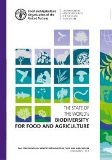
Genetic resources
Genetic resources for food and agriculture are the raw materials upon which the world relies to improve the productivity and quality of domesticated plant and animal populations, as well as to maintain healthy populations of wild species, including those used in forestry and fisheries. The conservation and sustainable use of genetic resources for food and agriculture is therefore at the core of food security and nutrition. Conserving and using a wide range of diversity – both among species and within species – means securing options to respond to future challenges.
FAO's role in genetic resources
The diversity of genetic resources for food and agriculture (i.e. plants/crops, animals, aquatic resources, forests, micro-organisms and invertebrates) plays a crucial role in meeting basic human food and nutritional needs. It is essential for maintaining and enhancing the efficiency and the resilience of production systems, as well as for healthy diets and the delivery of ecosystem services, such as pollination and pest and disease regulation.
FAO contributes to international policy through the work of its Commission on Genetic Resources for Food and Agriculture and the International Treaty on Plant Genetic Resources for Food and Agriculture.
- The Commission, which is the only intergovernmental forum specifically dealing with biodiversity for food and agriculture, oversees and guides the preparation of periodic global assessments and negotiates global action plans, codes of conduct and other instruments relevant to conservation and sustainable use.
- Through the International Treaty, which is the only international legal and operational instrument covering all plant genetic resources for food and agriculture, countries and users get access to genetic resources for research, training and breeding and participate in the benefits derived from their use.
From assessments to policy
The Commission’s global assessments are country-driven and based on national assessments of the state of genetic resources, their use, the drivers of change affecting them and the challenges and opportunities involved in conserving and using them in a sustainable manner to contribute to food security and nutrition.
To address the main gaps and challenges identified in the assessments, the Commission negotiates Global Plans of Action, policy instruments providing a framework to guide the implementation of actions at community, national, regional and international levels for the conservation and sustainable use of genetic resources for food and agriculture.
Exchange of genetic resources
All countries depend on genetic diversity from other countries and regions.
International cooperation and open exchange of genetic resources are therefore crucial for food security.
The global operational systems of the International Treaty, which include the Multilateral System of Access and Benefit-sharing and the Global Information System on Plant Genetic Resources for Food and Agriculture, facilitate the exchange of plant genetic resources and relevant information.
The work of FAO in this area contributes to the achievement of Sustainable Development Goals 1, 2, 12, 13 and 15.
Key facts
- In 2021, of a global total of 8 771 mammalian and avian breeds used for food and agriculture, 2 281 were classified as being at risk of extinction and 619 as extinct
- There are almost 400 000 plant species
- There are over 60 000 tree species
- There are over 160 000 species of fish, and aquatic molluscs, crustaceans and plants
- Micro-organisms and invertebrates are the most numerous groups of species on Earth. However, 99% of bacteria and protist species remain unknown
Publications
- The role of genetic resources for food and agriculture in adaptation to and mitigation of climate change
- ABS Elements
- Voluntary Guidelines for the Conservation and Sustainable Use of Crop Wild Relatives and Wild Food Plants
- Developing sustainable value chains for small-scale livestock producers



